If you want to have photos with a strong Western style but limited budget, why not visit these 10 beautiful churches in Vietnam below. Surely you will have a million-like photo with Western style right in Vietnam.
1. Tan Dinh Church
Address: 289 Hai Ba Trung, Ward 8, District 3, Ho Chi Minh City.
Tan Dinh Church, also known as the Sacred Heart of Jesus Church, is a place that has recently attracted domestic and international tourists to visit. What attracts tourists here is the church with a pink color that looks cute and lovely, standing out in the heart of Saigon.
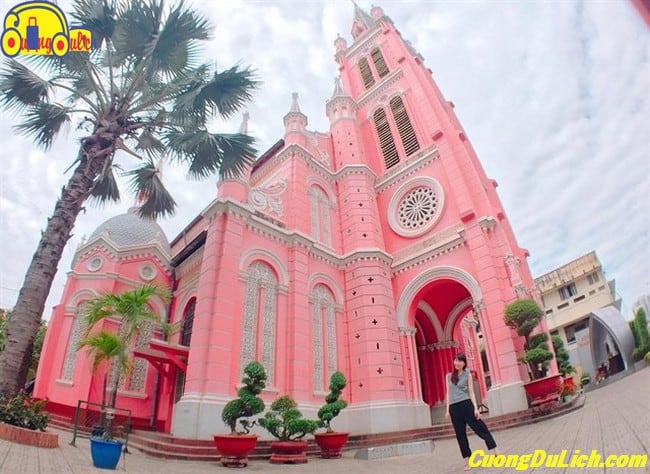
Where is Tan Dinh Church located?
Located at 289 Hai Ba Trung, Ward 8, District 3, on a bustling street with a busy flow of people and vehicles, making it easy for tourists to travel here by any means. Whether by motorbike, car, taxi, or bus, tourists from districts 2, 4, 1, 7 can easily reach here in about 20-30 minutes. Taking the bus is also very convenient, just catch bus number 63 and you’re there.
Architecture of Tan Dinh Church
Tan Dinh Church was built in 1870, making it one of the oldest churches in the city. By 1929, the church was expanded and a 52.60m tower was added, renovating the bell tower. With classic Roman architecture and a unique design, adorned in a fresh pink color, it creates a magnificent beauty in the Saigon sunlight.
Tan Dinh Church is made of Italian marble. Looking from the outside, visitors will see the main tower and two side towers with corridors topped with tiled vaults in a fish scale pattern, delicately decorated with flowers, leaves, angel statues, and round windows. The main highlight is the 3m high copper crucifix at the top of the tower, symbolizing those who follow the Catholic faith. The two side towers have many lantern towers with decorative ventilation holes adorned with elegant floral patterns.

Entering deep into the Cathedral, visitors will be amazed by the ancient architecture with two rows of Gothic columns leading to the main altar. Most of the altars in the Cathedral are made of precious stones imported from Italy. If you pay close attention, you will notice that the row of columns on the left side features statues of female saints, while the row on the right side features statues of male saints. Inside the tower, there are 5 bells weighing about 5.5 tons, creating a unique architectural masterpiece with intricate carvings, making visitors feel like they are wandering into a dreamy, classical Italian city, an interesting feeling that everyone would want to experience at least once.
As a cultural architectural work, this is also a place where charitable activities are organized, as well as a destination for people of faith to come and worship, pray for blessings, peace, or listen to sermons at the Cathedral. It seems like visitors are sitting in a European church with a spacious, classical atmosphere.
The beauty of Tan Dinh Church
After a full tour, admire the architecture of Tan Dinh Church. Listen to the Cathedral bells ringing, watch the sunset gradually fading with drifting clouds. Visitors can easily enjoy peaceful moments, rare in the bustling, vibrant city.
It becomes even more wonderful when this place attracts not only domestic and international tourists but also becomes a popular check-in spot for many young people, couples who come to explore and discover Tan Dinh Church.
From the colors to the architecture, Tan Dinh Church has captivated tourists and young people when they visit. There is no reason not to come here right away. If you have chosen Tan Dinh Church as a destination, visitors should head to Saigon immediately.
2. Notre-Dame Cathedral Basilica of Saigon
Address: 01 Cong xa Paris, Ben Nghe, District 1, Ho Chi Minh City
History of Notre-Dame Cathedral Basilica
When talking about Notre-Dame Cathedral Basilica, this is definitely one of the most magnificent architectural wonders in Vietnam. This grand structure was completed in 1880 (precisely on Easter Sunday, April 11, with Bishop Colombert presiding over the solemn consecration and dedication of Notre-Dame Cathedral Basilica). Behind its grandeur lies countless fascinating stories.
The French brought Catholicism to Vietnam during the war, and they – like any other person, had absolute faith in their God. The first Catholic church built by the French in Saigon was from a small abandoned temple (located on what is now Ngô Đức Kế Street).
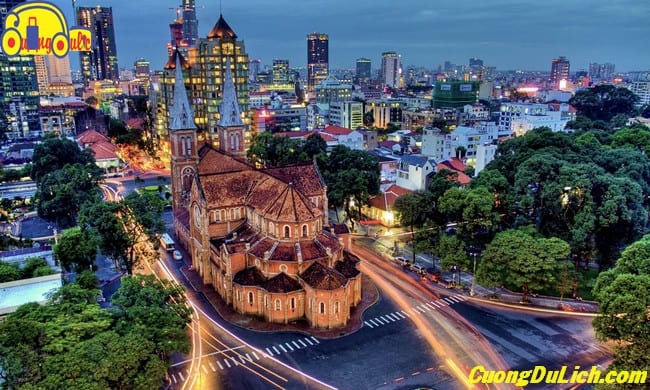
After several renovations, the French realized that the demand for religious worship in the six provinces of Southern Vietnam was increasing. In 1876, Governor of Southern Vietnam Duperré organized a competition to design a large church. The design by architect J. Bourard, with a mix of late Romanesque and Gothic architectural styles, was chosen. Understanding the importance of this project, Duperré imported all construction materials directly from France. You can see the distinctive red brick color of Notre-Dame Cathedral that does not collect dust or moss after over 130 years.
Outstanding Architecture of Notre-Dame Cathedral
Bronze Statue of Pigneau de Béhaine:
Cast by the French in 1903, the main figure in the statue is Bishop Pigneau de Béhaine (also known as Bishop Bá Đa). He is depicted leading a young man in his twenties, who is Prince Nguyễn Phúc Cảnh (son of King Gia Long) – symbolizing the harmony between Catholicism and the Nguyen Dynasty at that time. By 1945, the statue was dismantled, leaving only the solid granite pedestal…
Statue of Our Lady of Peace:
After a long period of being empty, in front of the main gate of Notre-Dame Cathedral, it wasn’t until 1958 that Father Joseph Phạm Văn Thiên placed a statue of Our Lady of Peace made of Carrara marble from Italy. After completion, the statue was transported to Saigon by sea, and a year later, it finally touched the original granite pedestal. After a solemn consecration ceremony, a hole was carved under this granite pedestal to hold a silver box containing prayers for peace during ceremonies. These prayers were written on thin sheets made of various materials such as gold, silver, tin, aluminum, paper, leather, and copper, sent from various regions of Vietnam, including some from outside the North.
Distinctive Architectural Features of Notre-Dame Cathedral:
As mentioned, Notre-Dame Cathedral is the result of a fusion between late Romanesque and Gothic architecture. The overall arrangement of the church, the sanctuary, and the aisles of this cathedral exude the characteristic ancient beauty of the late Romanesque period. Combined with that overall structure is the heavily decorated windows, main door, vaults, and steep roofs following the traditional Gothic style.

Two white spires and a 28-ton bell:
Originally not part of the original design, the addition of these two spires at the Notre-Dame Cathedral inadvertently shaped the Gothic architectural style that was often confused in the past. This addition also significantly increased the total height of the bell towers. As for the 6 special bells inside, they were specially made in France, with 6 bells corresponding to the 6 musical notes sol/do/re/mi/la/si. The tower on the right holds 4 notes sol/do/re/mi and the tower on the left holds two notes la/si.
Located in the heart of District 1, Notre-Dame Cathedral Saigon is one of the most easily accessible destinations for long-distance travelers. From here, you can find travel companies, hotels, famous landmarks, museums, or individual restaurants and cafes. Conversely, travelers can also reach Notre-Dame Cathedral by public transportation such as buses, taxis, or even motorbikes or cyclos.
With its spacious area and low traffic density, this is also an ideal place for tourists to stroll or sit down for a small cup of coffee. Near Notre-Dame Cathedral are famous landmarks of Ho Chi Minh City such as Independence Palace, Turtle Lake, and the Vietnam History Museum…
3. Thai Binh Cathedral
Address: 8 Tran Hung Dao Street, Le Hong Phong Ward, Thai Binh City, Thai Binh Province.
Where is Thai Binh Cathedral located?
Situated on a plot of land about 1,500m2, Thai Binh Cathedral is designed in a Gothic style combined with a touch of modern Eastern architecture, creating a harmonious overall look. Therefore, the new cathedral still retains the traditional features of a Western church, with two symmetrical towers, while also incorporating Eastern style with curved roofs, round columns, and stylized conical shapes…

The beauty of Thai Binh Cathedral
The church is designed with two floors, with a total length of 69 meters; 18 meters wide for internal use and two long corridors with a width of 3 meters. The upper floor of the church is used for conducting Mass and other liturgical ceremonies.
The cathedral is adorned in a bright cream-colored coat, leaning towards the color of alluvium, reminiscent of a land of rice that once made its mark in history. Located in the basin of two major rivers, the Red River and the Tra Ly River, the homeland of Thai Binh has been enriched and nurtured by a layer of rich alluvium, making Thai Binh once the rice granary of Northern Vietnam. It is this land full of potential that has produced the kind, simple-hearted people of Thai Binh, who are compassionate and hardworking in everyday life but resilient in the challenges of faith.
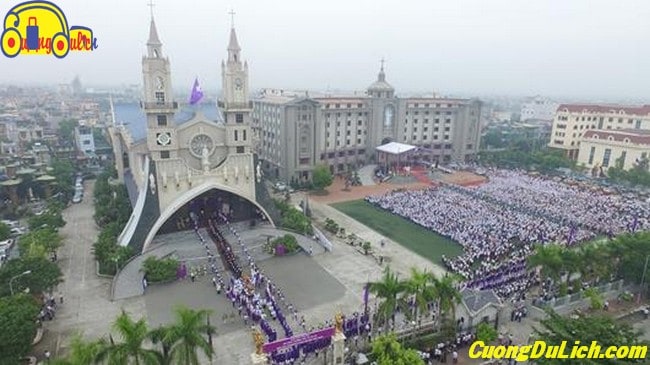
The Cathedral of the Chính Tòa Church was newly built on the foundation and central axis of the previous church. However, it was shifted about 30 meters towards the front of the church to create a large open space at the back of the church, turning it into a square for grand ceremonies.
Overall, we can easily see that the architectural space leans more towards nature. Stepping into the church grounds, one feels like entering a completely different world. Here, they rediscover peace and rare moments of tranquility after hard days of work.
4. Phủ Cam Church
Address: 1 Đoàn Hữu Trưng, Phước Vĩnh, Huế City, Thừa Thiên Huế.
Where is Phủ Cam Church located?
Phủ Cam Church sits atop a small hill named Phước Quả, in Phước Vĩnh ward, Huế City; located on the southern bank of the Perfume River. The structure has a beautiful position, overlooking a large area, surrounded by other church buildings. Phủ Cam Church is one of the largest and most famous churches in Huế with a long history.
The origin of the name “Phủ Cam”
Is it Phú Cam Church or Phủ Cam Church? Phủ Cam consists of Phủ from the residence of a high-ranking official or royal family, and Cam from the Cam tree orchard. Previously, this area was the location of the residence that grew Cam trees. The name Phú Cam is derived from Phủ being mispronounced as Phú.
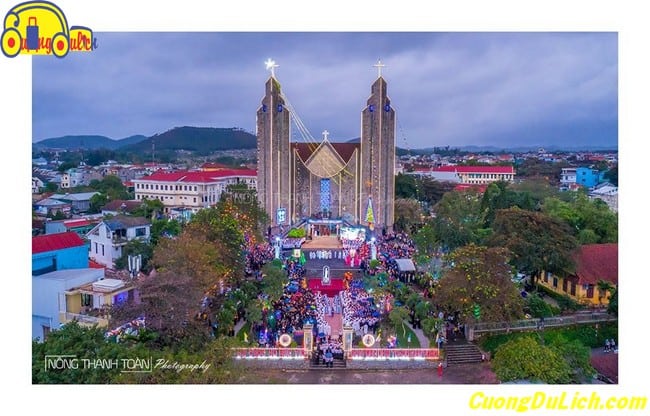
History of the construction of Phu Cam Church
The initial church of Phu Cam was a bamboo church built in Xom Da, near the An Cuu River in 1682. However, only 2 years later, the Phu Cam church was moved and rebuilt on Phuoc Qua Hill (the current church location). During the reign of Lord Nguyen Phuc Chu (1691 – 1725), the church was completely demolished in 1698.
Exactly two centuries later, in 1898, Phu Cam Church was rebuilt. The construction was completed in 1902, in the Gothic architectural style. However, this church was replaced in the 1960s for various reasons, including the expiration of its usage period and the increasing number of parishioners in Phu Cam.
In 1960, after the Diocese of Hue was elevated to an Archdiocese, the old church was demolished and a larger new church was built based on the design by architect Ngo Viet Thu. This is the current Phu Cam Church.
The main Phu Cam Church is located in Phuoc Vinh Ward, Hue City. It is a modern architectural church designed by architect Ngo Viet Thu. In early 1963, the church construction began. It was not until 1967 that the sanctuary was completed. By 1995, the main body of the church was essentially completed.
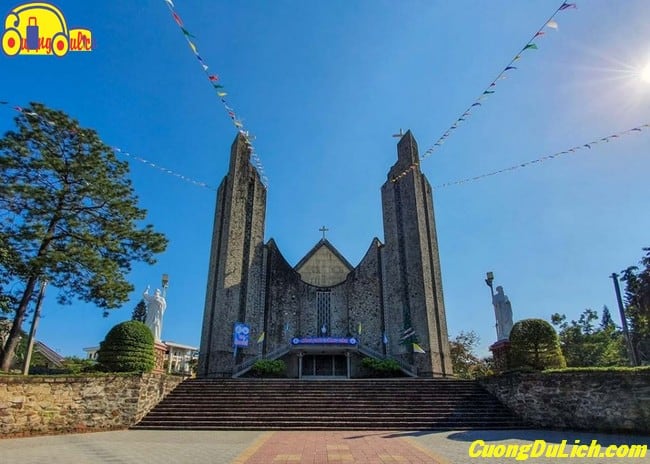
Architecture and Beauty of Phu Cam Cathedral
Phu Cam Cathedral is built according to the new structural physics concept. The supporting pillars are cast close to the wall, gradually curving forward, softly. Each of the four corners has three supporting pillars gradually extending out, creating a sufficiently wide space that encloses the sanctuary and altar.
The interior of the church is built in the classical tradition with a Latin cross shape plus an extended nave. There are two rows of colored glass windows located at the upper part inside the church, with a cement iron cross in the middle.
- The sanctuary is a circular shape with ascending levels, above the sanctuary is a smaller circle with a solid marble altar.
- The tabernacle, built close to the rear of the church, fits neatly into the recessed area at the back and is placed on a high pedestal right in the center.
- On the two wings of the church’s cross shape, the left wing is the tomb of the late Archbishop Philip Nguyen Kim Dien (1921 – 1988), the opposite right wing is the altar of the scriptures.
- In front of Phu Cam Cathedral, there are two cast statues: on the right is Saint Peter, on the left is Saint Paul, who are also the patrons of Phu Cam parish.
- The front of Phu Cam resembles a dragon’s mouth opening, overall, Phu Cam Cathedral with its spire reaching straight to the sky still looks very graceful and light, full of art and religion.
5. Nha Trang Cathedral
Address: No. 1 Thai Nguyen Street, Phuoc Tan Ward, Nha Trang City, Khanh Hoa Province.
Where is Nha Trang Mountain Church located?
Nha Trang Mountain Church, also known as Nha Trang Cathedral. Located on a small hill near Nga Sau, the center of Nha Trang City, the Cathedral is a place that attracts many tourists. The official name of the church is Christ the King Cathedral, but it is often referred to by locals with simple and familiar names such as: Stone Church, Mountain Church. The church’s construction began on September 3, 1928. In the past, this was a wild land, when the French came to Nha Trang, they split Hon Mot Mountain. The western half of this mountain was flattened by 500 mines to have an area of 4,500m2 to build the church. In December 1941, the construction was completed, and thus the name Mountain Church was born.
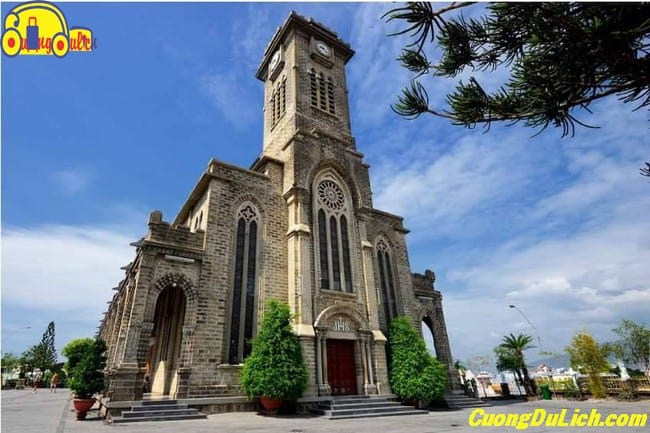
The beauty of Nha Trang Mountain Church
From a distance, many people still mistakenly think that this massive architectural structure is built with split stones, but in fact, split stones are only used for paving roads and yards. The entire walls of the church are built with cement blocks. Father Louis Vallet and his colleagues directly cast these cement blocks. Especially, only the flat roof of the corridors running along both sides is poured with reinforced concrete, while the entire vaulted roof of the prayer hall is made of bamboo reinforcement and steel mesh.
Nha Trang Mountain Church embodies the Gothic architectural style with 3 distinct parts: the lower part is the entrance, the middle part is a large round stained glass window adorned with roses, and the upper part consists of corridors and two bell towers. The unique feature of the church is the set of bronze bells hung on the bell towers. These bells were made and supplied by the famous French bell foundry Bourdon Carillond. During a royal visit in February 1933, King Bao Dai visited the church while the construction was still ongoing. At that time, the bronze bells cast in France were temporarily hung on wooden towers. The first bell with the sound of E was consecrated by the church on July 29, 1934, and the other two bells with the sounds of C and A were consecrated in 1939. There is also a large clock attached to the bell tower, with 4 faces pointing in 4 directions.
The sanctuary of Nha Trang Mountain Church
The most prominent feature of Nha Trang Church is the sanctuary area. Stepping through the front door, you will encounter a vast, spacious space filled with light. The most outstanding feature of Gothic architecture here is the soaring, wide, and skyward-pointing curved vaults. The decorative patterns use straight segments, arranged harmoniously, creating a simple yet solemn beauty. The 14 Stations of the Cross (the Passion of Jesus) are depicted by paintings hanging on the walls. In addition, to harness the sunlight from the East and West, the designers installed various green and red stained glass windows in the vaults and rose windows. All of these elements create a beautiful and gentle scene, softening the solemn atmosphere typically found in places of worship. The sanctuary area is an open space, with colorful stained glass windows creating a vibrant and elegant beauty. “I am extremely impressed by the skilled hands of the craftsmen who built this structure,” said Mr. Nguyen The Trong, a tourist from Ho Chi Minh City.
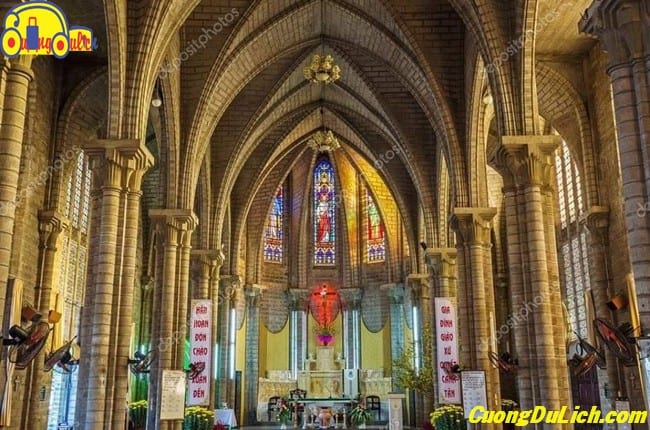
The Mountain Church has been present in Nha Trang for over 80 years. From a distance, it looks like an ancient Roman castle. Standing firmly on a hilltop, with its gray coat, this construction remains steadfast, proudly facing the rain, sun, and misty wind. For the Catholic community in Nha Trang City, the Mountain Church holds a very important position, where they come to pray for divine grace. Additionally, many couples choose this place to hold their weddings, symbolizing the blossoming and fruition of love. This is also a favorite destination for tourists visiting Nha Trang – Khanh Hoa. Besides sightseeing and admiring the unique architecture, visitors will have moments of relaxation and tranquility while enjoying the romantic atmosphere of the coastal town…
6. St. Joseph’s Cathedral
Address: 40 Nha Chung Street, Hoan Kiem District
The beauty of St. Joseph’s Cathedral in Hanoi
St. Joseph’s Cathedral in Hanoi is designed in the Gothic architectural style of medieval Europe. This architectural style was very popular in the 12th century during the Renaissance in Europe.
Overall, St. Joseph’s Cathedral resembles Notre-Dame Cathedral in Paris, a typical Catholic church representing the Gothic architectural style in France. The main materials used for building the church are fired bricks and plaster.

Overall, the church is about 65m long, 21m wide, with two bell towers reaching about 32m in height. With such dimensions, visitors can see the grandeur and majesty of this cathedral. At the top of the church is a stone cross, below which are a clock and a statue of a saint, creating focal points for the church’s architecture.
From the outside, the church looks very ancient with layers of weathered lime and moss-covered tiled roofs. However, upon entering through the large doors of the church, visitors will be amazed by the magnificent and unchanged architectural features over time.
According to the travel experience of some tourists in Hanoi, it is only by entering the church that visitors can truly appreciate the grandeur of this structure.
Visiting the Cathedral
Upon entering the church, the first thing that attracts visitors is the Sanctuary. The Sanctuary in the church is decorated in a simple yet eye-catching traditional folk art style. In the middle of the Sanctuary is a statue of Saint Joseph holding Baby Jesus, with altars to the Virgin Mary and various other saints on the sides and around the Sanctuary.
Beneath the main hall are long benches with kneelers to serve the faithful during Mass. With its spacious interior, the Cathedral can accommodate up to thousands of people. During major holidays like Christmas, the Cathedral attracts a large number of worshippers and tourists.
In the church’s vestibule, there is a large door, with two small doors on each side of the towers for the convenience of worshippers and visitors. All the doors and windows in the church are pointed in the Gothic style. Inside the pointed doors are beautiful stained glass paintings of saints.

Outstanding Bell Tower
The church also has a valuable set of Western bells (about 20,000 French francs at that time), consisting of four small bells and one large bell. Next to it is a large clock attached to the front of the church. The clock has engravings, hour chimes, a bell system linked to 5 bells hanging on the tower. The church bells serve the purpose of announcing activities for Christians to know the time of the start of the liturgy, baptism, marriage, or the passing of someone, etc. Unlike the sound and ringing style of temple bells, church bells have a fast or slow rhythm depending on the different purposes of the announcements.
Outside the church, there is a small square where a metal statue of the Virgin Mary is placed. Below the statue of the Virgin Mary is an incense burner for people to light incense and pray, surrounded by many pots of fresh green plants. The fence around the statue is deeply Catholic with patterns created from the shape of the cross.
Big Church Square
Hanoi’s Big Church is a special destination, attracting local people and tourists from near and far. The neighborhood around the church has long been a familiar gathering place for young people and tourists. Just finding an ideal seat, enjoying a drink while admiring the ancient church is enough for visitors to feel relaxed and comfortable.
Students from nearby schools often gather to play soccer and have fun in front of the church gate. Couples, soon-to-be-married, often choose the area around the church as a dating spot or for wedding photos.
7. Kon Tum Wooden Church.
Address: 13 Nguyen Hue Street, Thong Nhat Ward, Kon Tum City, Kon Tum Province
Where is the Kon Tum Wooden Church located?
The Cathedral or as the locals here often call it the Kon Tum Wooden Church, was built by a French pastor in 1913. The ceiling and walls are made of earth mixed with straw. On the ancient walls are stained glass windows depicting images of Jesus and the Virgin Mary.The Kon Tum Wooden Church is located on Nguyen Hue Street, Kon Tum City. The church was entirely made of red cajuput wood and completed in 1918.

The beauty of Kon Tum wooden church
Kon Tum wooden church is a masterpiece designed in Romantic architecture, harmoniously combining the stilt house style of the Ba Na people, thus imbued with the cultural and religious essence of the highland people from the patterns to the highlights on the materials. The church is a closed complex consisting of: a church, a guest house, a display house for ethnic products and religion, and a communal house
The garden area of the church features a statue of the Virgin Mary holding the Child Jesus made from a single piece of primitive wood, carved in the rustic style of the Central Highlands ethnic groups. Additionally, the crucifix and decorative statues both inside and outside the church, such as sheep and saint statues made from tree root bases, further enhance the space with the vibrant colors of the Central Highlands
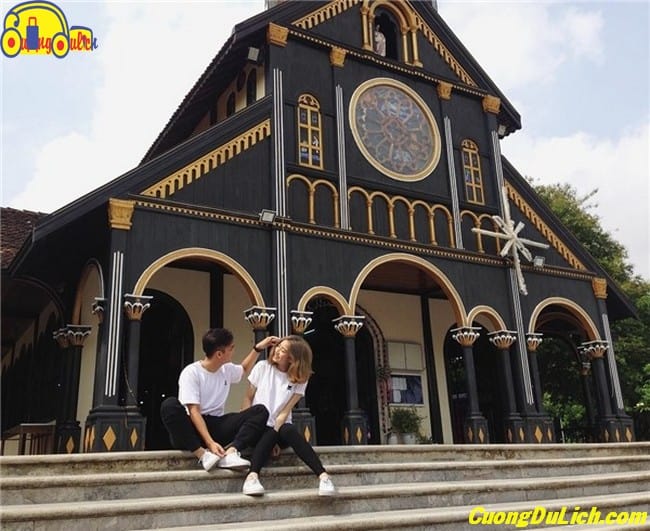
Inside the church is a sacred and solemn atmosphere, while outside is a large courtyard with many trees and flowers providing shade, especially the beautiful white lilies. On weekends, many people come to the church to read prayers and the sound of the Holy Scriptures echoing from the church makes me feel deeply moved.
A priest mentioned that the Wooden Church was entirely built by hand, showcasing the talent of artisans from the Kinh ethnic group from Binh Dinh, Quang Nam, and even from the North.
The church is also a miniature museum of the Central Highlands
This is a small museum displaying household items, agricultural tools, and cultural objects of ethnic minorities living in this province. The artifacts and maps displayed in the seminary are very valuable, intricately carved from wood. What is admirable is that there is no entrance fee, no requirement for donations, and even if there is only one visitor, the young guide from the seminary enthusiastically shares stories with a deep understanding of history, culture, and beliefs…
If you visit Kon Tum and miss the Wooden Church, it would be a big loss! For those who love taking photos, this is a place you cannot miss.
8. Phat Diem Church
Address: Phat Diem Town, Kim Son, Ninh Binh 430000
Where is Phat Diem Church located?
The main Phat Diem Cathedral is a Catholic church complex covering about 22 hectares, located in Phat Diem town, Kim Son district, Ninh Binh province, about 120 km south of Hanoi.Phat Diem Church is 120km south of Hanoi, built between 1875 – 1898. Phat Diem means the emergence of beauty, a name given by Nguyen Cong Tru.
The beauty of Phat Diem Church
The church was built continuously over 24 years, with the technical expertise and transportation conditions of the late 19th century, transporting thousands of tons of stone, some weighing 20 tons, and hundreds of ironwood trees to Phat Diem for construction was a remarkable feat.
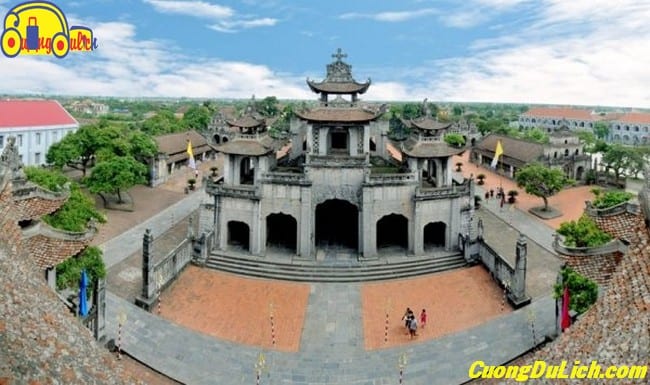
Visitors can come to Phat Diem Cathedral at any time of the year, combined with a trip to Ninh Binh. However, the best time to visit Phat Diem Cathedral is probably during Christmas, the largest community event for the local parishioners. On Christmas Eve, many meaningful activities will take place, beautifully decorated and meticulously prepared, which will leave visitors in awe of the magnificent beauty of Phat Diem Cathedral at night.
Guide to visiting Phat Diem Cathedral
Directions to Phat Diem Stone Cathedral in Ninh Binh are as follows: From Hanoi, take National Highway 1 to Ninh Binh city, then follow road number 10 for 28km to Phat Diem town. On road number 10, you will see the newly restored ancient tile bridge, go about 100m further along a 250m long asphalt road (Middle Road) to reach Phat Diem Cathedral.

Experience visiting Phat Diem Cathedral in Ninh Binh suggests an itinerary for visiting Phat Diem Cathedral as follows:
- Visit Phat Diem Cathedral in Ninh Binh to see the lake, monument, Phuong Dinh, the main church, Roco Bible prayer house, Heart of Jesus prayer house, St. Joseph prayer house, St. Peter prayer house, and artificial caves… shop for souvenirs, and buy local specialties from Kim Son.
- Continue to visit and take photos at Phat Diem Tile Bridge – a bridge that was once featured on Vietnamese postage stamps.
9. Domaine de Marie Church
Address: 1 Ngo Quyen, Ward 6, Da Lat City, Lam Dong 670000
Where is Domaine De Marie Church located?
Domaine De Marie Church (Mai Anh Parish) Address: 1 Ngo Quyen Street, Ward 6, Da Lat City, Lam Dong. Domaine de Marie Church is also known as Vinh Son Church (as it is the prayer house of the Sisters of Charity of Vinh Son), Mai Anh Church (as this area used to have many apricot blossom trees)[1]. This is an architectural complex consisting of a prayer house and two rows of convents of the Sisters of Charity of Vinh Son with a total area of 12 hectares located on Ngo Quyen Street about 1 km southwest of the city center of Da Lat.
The church was started to be built in the years 1940 to 1944 when it was completed. The entire construction cost of the church was donated by the First Lady of Indochina Jean Decoux from contributions from the parishioners.With a total area of 12 hectares, this place is designed with a connected architectural complex. It includes a prayer house and two rows of convents of the Sisters of Charity of Vinh Son (Filles de la charité de saint Vincent de Paule).
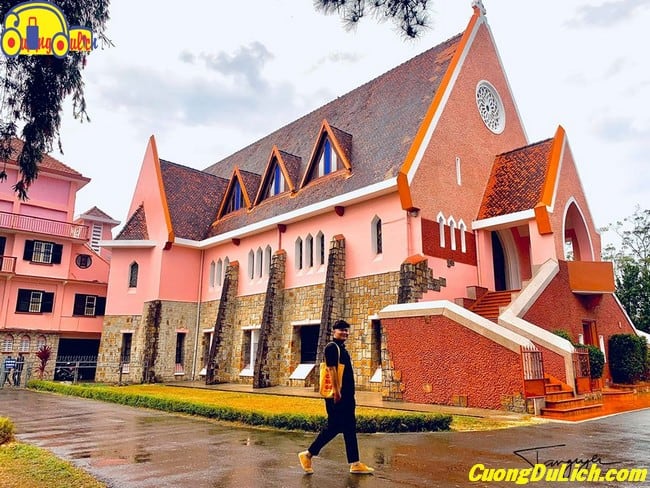
The beauty of Domain De Marie Church
Domain de Marie Church is built in classical architecture and strongly reflects the 17th-century European style. The stone walls are chiseled up to the window sills in the architectural style of the northern region of France. With a width of 11m and a length of 33m, the church’s roof system resembles the wide roofs of the Tây Nguyên ethnic people, covered with red tiles typical of the Vietnamese people.
One special feature in the design of Domain de Marie Church is the absence of a bell tower like other churches. The window frames are decorated with colorful stained glass, creating a beautiful appearance. Every visitor who comes to visit is amazed and enchanted.
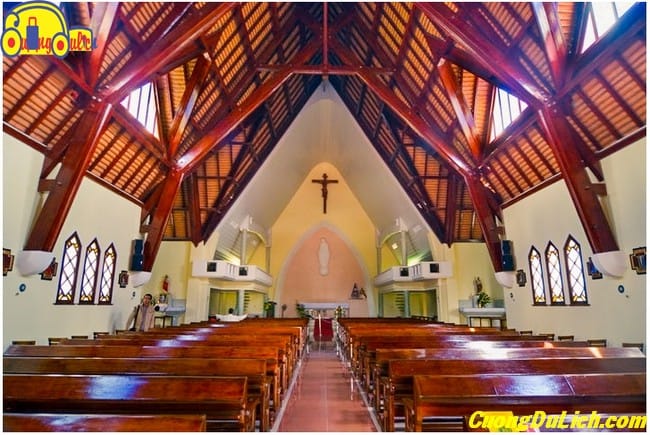
Nhà thờ là 1 cơ sở công ích
At first, the church was the main convent of over 50 nuns. They participated in social activities such as opening orphanages, nurseries, etc. Until now, although the main branch has moved to Ho Chi Minh City, they still uphold the principles of the order. Serving the poor, they have opened facilities to care for the developmentally challenged, orphans, provide medical care for the poor, open free vocational training centers, etc.
Currently, besides the prayer house and two convents, other facilities have been used for public purposes.
The church uses pink lime to paint the walls. This makes the church stand out when the sunlight shines in.When visiting the church, guests can also see a 3m high, 1-ton statue of the Blessed Mother standing on a globe. Designed by French architect Jonchere as a gift for the First Lady of Indochina. These distinctive features of the church contribute to attracting tourists to Da Lat.
10. Nhà Thờ Tân Hòa
Address: 525/92 Alley 525 Huynh Van Banh, Ward 14, Phu Nhuan, Ho Chi Minh City.
Nhà Thờ Tân Hoà is located where?
Nhà Thờ Tân Hoà formerly known as Kiến Thiết Church (1960), because it is located in the Kiến Thiết residential area, which was built in 1960, consisting of two areas: the Red Tile Area and the White Tile Area. The White Tile Area was built in 1957, and the Red Tile Area was built in 1960. These areas were constructed by Mr. Chánh Trương of Tân Hoà Parish, with the construction overseen by Mr. Micae Vũ văn Hoạt, who at the time worked in the Saigon Land Department. Kiến Thiết Church is located at the end of the White Tile Area, which was then still a swamp, with lush green grass. When it was first established, there were only a few dozen parishioners, less than 100 people. Later, thanks to the formation of the Red Tile Area, the number of parishioners increased to about 400 people. Tân Hoà Holy See.
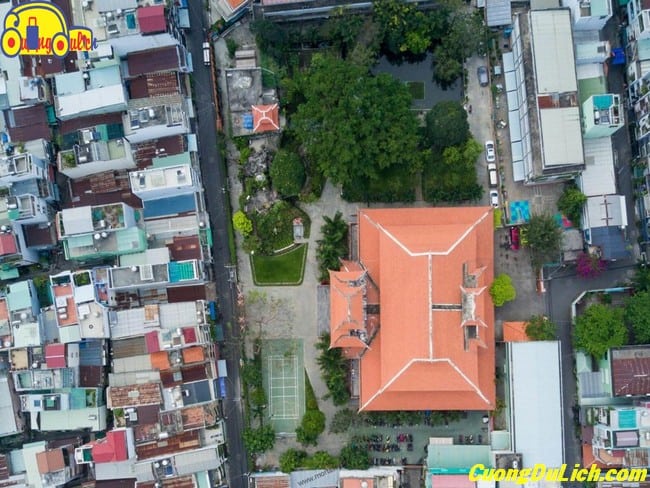
The beauty of Tan Hoa Church
The first church was built in 1966, from a small original prayer house. The church was initially built with a tin roof, low foundation, and often flooded after each rain. Surrounding the church are 3 ponds, each about 150 m2. There were kindergarten classes built on the pond, but after 1975 these classes were dismantled or no longer in use. During the second construction, 2 ponds were filled to build a statue of Mother Mary, and one was transformed into a natural tree garden to match the new architecture.

In November 1995, the construction of the Holy Mother Temple was dedicated to Mother Mary, including preserving the valuable relics of the old Holy Church, which will be discussed later about these relics.If you have the opportunity to visit Tan Hoa, on the stone pulpit in the Holy Temple, these lines are engraved on the pulpit and on the inside.
Above are the 10 most beautiful churches in Vietnam that we have collected. Do you know any other beautiful churches in Vietnam? Please share with us below.
